Basic Britain: sausages
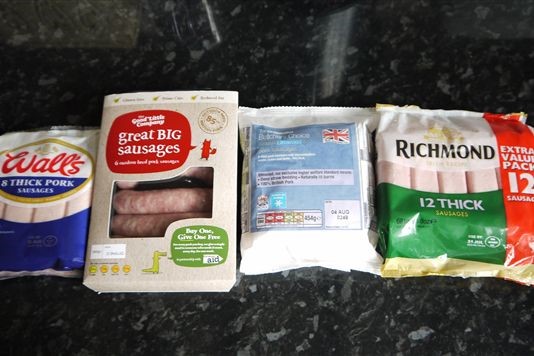
Whether they're being fired up on a barbecue, or crowning the perfect fry-up, the banger is something we can't live without. But how do the brands compare to the supermarket? Laura Rowe finds out.
Sausage love
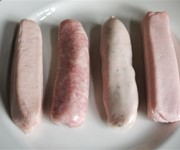 Here in the UK we eat a lot of sausages. In the last 12 months alone, 864 million of our meals involved sausages, and we spent an incredible £707 million on them. That’s what you call some serious sausage love. But what do you care about most when it comes to your banger? Is it buck? Is it taste? Or is it about where that sausage meat actually came from? With the sales of premium sausages dropping by 2.6% year-on-year, and the sales of economy sausages growing by 15.3% in the last year, I’ve taken a look at what your money really gets you. Here are my findings about the UK’s no.1 best-selling sausage Richmond, family-favourite Wall’s, premium and proud to be ethical, the Good Little Company and the co-op’s best-value sausage, British Elmwood Pork Sausages. We also approached Morrisons and ASDA who sadly declined to take part. Make of that what you will.
Here in the UK we eat a lot of sausages. In the last 12 months alone, 864 million of our meals involved sausages, and we spent an incredible £707 million on them. That’s what you call some serious sausage love. But what do you care about most when it comes to your banger? Is it buck? Is it taste? Or is it about where that sausage meat actually came from? With the sales of premium sausages dropping by 2.6% year-on-year, and the sales of economy sausages growing by 15.3% in the last year, I’ve taken a look at what your money really gets you. Here are my findings about the UK’s no.1 best-selling sausage Richmond, family-favourite Wall’s, premium and proud to be ethical, the Good Little Company and the co-op’s best-value sausage, British Elmwood Pork Sausages. We also approached Morrisons and ASDA who sadly declined to take part. Make of that what you will.
How do they cook?
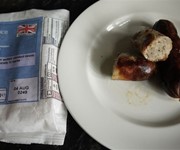 I cooked all four according to packet instructions, which all recommend grilling for best results. The co-op’s Butchers Choice British Elmwood Pork Sausages (£1.85/454g) are attached together in a traditional string of eight, but when cooking some of the sausages’ skins popped. The skins of Richmond Thick Sausages (RRP £2.09/454g) and Wall’s Thick Pork Sausages (RRP £2.28/454g), both made by Kerry Foods Ltd, also split. All three sausage makers use beef collagen as casing instead of traditional pig intestine. The animal by-product reduces the cost of production and allows for uniformity. Kerry Foods Ltd says it uses beef collagen for “food safety and food quality”. It was only the Great Big Sausages (RRP £2.89/360g) from The Good Little Company (TGLC) that didn’t split during cooking – and these are made using natural hog skin casings. Wall’s, which has 9.2g of fat per 48g sausage, leaked the most fat during cooking; Richmond came second, which has 7.8g of fat per 49g sausage; co-op third, which has 10.7g of fat per 57g sausage; and TGLC had the least fat leaking during cooking – it has 7.5g per 60g sausage.
I cooked all four according to packet instructions, which all recommend grilling for best results. The co-op’s Butchers Choice British Elmwood Pork Sausages (£1.85/454g) are attached together in a traditional string of eight, but when cooking some of the sausages’ skins popped. The skins of Richmond Thick Sausages (RRP £2.09/454g) and Wall’s Thick Pork Sausages (RRP £2.28/454g), both made by Kerry Foods Ltd, also split. All three sausage makers use beef collagen as casing instead of traditional pig intestine. The animal by-product reduces the cost of production and allows for uniformity. Kerry Foods Ltd says it uses beef collagen for “food safety and food quality”. It was only the Great Big Sausages (RRP £2.89/360g) from The Good Little Company (TGLC) that didn’t split during cooking – and these are made using natural hog skin casings. Wall’s, which has 9.2g of fat per 48g sausage, leaked the most fat during cooking; Richmond came second, which has 7.8g of fat per 49g sausage; co-op third, which has 10.7g of fat per 57g sausage; and TGLC had the least fat leaking during cooking – it has 7.5g per 60g sausage.
How do they taste?
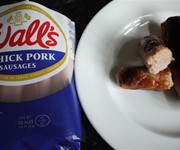 Even though three of the sausages split during cooking, they were all really moist. The three collagen skins still had the familiar pop you want from the skin and went suitably crispy, while the natural casings on the TGLC sausages were actually a little chewy. This premium sausage definitely had the best texture meat though. Made using 85% pork, using shoulder and belly, the banger had a good, rough texture. The spicing is very subtle (black pepper, ginger, pimento, mace and nutmeg) and there is only 0.7g of salt per sausage. Richmond has 42% pork (the minimum amount required by law and consequently why they're labelled as just sausages, rather than 'pork sausages') and – along with Wall’s, which has 61% pork in its sausages – uses a variety of cut combinations including shoulder, belly and trimmings, and the salt content for both is impressively under 2%. Both of these sausages had a distinctive smooth texture, perhaps thanks to the addition of potato starch, rusk and water in both, but the flavours were very different. Wall’s was sweeter and had a distinctive spiciness – it includes onion powder and herbs in its recipe – while Richmond was the plainest tasting of all the sausages, perhaps explaining why it is the best seller. The co-op, which contains 74% pork and uses “pork trim and pork fat”, has flecks of herbs throughout its Butchers Choice sausage and a strong sage flavour coming through. It had a bit more texture but the odd bit of gristle, too. Its salt content was 0.65g per sausage.
Even though three of the sausages split during cooking, they were all really moist. The three collagen skins still had the familiar pop you want from the skin and went suitably crispy, while the natural casings on the TGLC sausages were actually a little chewy. This premium sausage definitely had the best texture meat though. Made using 85% pork, using shoulder and belly, the banger had a good, rough texture. The spicing is very subtle (black pepper, ginger, pimento, mace and nutmeg) and there is only 0.7g of salt per sausage. Richmond has 42% pork (the minimum amount required by law and consequently why they're labelled as just sausages, rather than 'pork sausages') and – along with Wall’s, which has 61% pork in its sausages – uses a variety of cut combinations including shoulder, belly and trimmings, and the salt content for both is impressively under 2%. Both of these sausages had a distinctive smooth texture, perhaps thanks to the addition of potato starch, rusk and water in both, but the flavours were very different. Wall’s was sweeter and had a distinctive spiciness – it includes onion powder and herbs in its recipe – while Richmond was the plainest tasting of all the sausages, perhaps explaining why it is the best seller. The co-op, which contains 74% pork and uses “pork trim and pork fat”, has flecks of herbs throughout its Butchers Choice sausage and a strong sage flavour coming through. It had a bit more texture but the odd bit of gristle, too. Its salt content was 0.65g per sausage.
What else is in there?
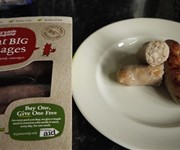 Make a sausage at home and your ingredients might include pork, spices and perhaps breadcrumbs; but commercial sausages need a little extra help. The presence of ‘stabilisers’, ‘preservatives’ and ‘antioxidants’ in Walls and Richmond are used for food safety and to extend the products’ shelf-life, which would only be a few days without them, according to Kerry Foods Ltd. The co-op uses a similar additives in its sausages “to help maintain the product quality over its shelf-life”, while TGLC has one antioxidant (ascorbic acid) and one preservative (E223), again to “prolong shelf-life”. These sausages are also good for coeliacs as they don’t use rusk like the others, but a gluten-free crumb made using maize flour, rice flour and chickpea flour.
Make a sausage at home and your ingredients might include pork, spices and perhaps breadcrumbs; but commercial sausages need a little extra help. The presence of ‘stabilisers’, ‘preservatives’ and ‘antioxidants’ in Walls and Richmond are used for food safety and to extend the products’ shelf-life, which would only be a few days without them, according to Kerry Foods Ltd. The co-op uses a similar additives in its sausages “to help maintain the product quality over its shelf-life”, while TGLC has one antioxidant (ascorbic acid) and one preservative (E223), again to “prolong shelf-life”. These sausages are also good for coeliacs as they don’t use rusk like the others, but a gluten-free crumb made using maize flour, rice flour and chickpea flour.
Where does the pork come from?
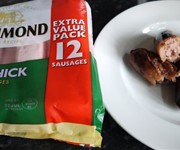 We’re all aware of the different types of conditions chickens are exposed to when we shop, but what do we understand about pork? Watch this film by sausage-maker Jimmy for a glimpse. TGLC uses British outdoor-bred pork from “happy pigs”. The pigs are born outside, with shelters “in case they get cold”, are housed in spacious barns with deep straw “for super comfort”, and are allowed to root and forage freely, which creates lean meat. The firm says it is this high welfare, premium choice of cuts, natural casing and gluten-free crumb (which is more expensive than gluten-free rusk) which creates TGLC’s high price point. For every pack that is sold TGLC is also currently running a “Buy One, Give One Free” campaign, which sees a staple meal donated to someone who needs it most, every day for one week, for every pack that is sold, in partnership with Christian Aid.
We’re all aware of the different types of conditions chickens are exposed to when we shop, but what do we understand about pork? Watch this film by sausage-maker Jimmy for a glimpse. TGLC uses British outdoor-bred pork from “happy pigs”. The pigs are born outside, with shelters “in case they get cold”, are housed in spacious barns with deep straw “for super comfort”, and are allowed to root and forage freely, which creates lean meat. The firm says it is this high welfare, premium choice of cuts, natural casing and gluten-free crumb (which is more expensive than gluten-free rusk) which creates TGLC’s high price point. For every pack that is sold TGLC is also currently running a “Buy One, Give One Free” campaign, which sees a staple meal donated to someone who needs it most, every day for one week, for every pack that is sold, in partnership with Christian Aid.
Wall’s and Richmond meat isn’t free-range but it does take animal welfare very seriously. All suppliers are approved by Kerry Foods Ltd own auditors and external statutory bodies, plus the meat has to conform to the relevant British and European legislation. A spokesperson for the firm said “those suppliers would use both wood shavings and slats at different stages of the pig life cycle”. Given the amount of pork needed for these major brands, Kerry Food Ltd says that Britain is not self-sufficient in pork manufacturing needs, so suppliers are sourced from both the UK and within the EU. The sausages are then made here in Manchester.
The co-op uses specialist pig farmers rearing Elmwood pigs. They are 100% British and bred in naturally lit barns with deep straw bedding. The supermarket says “all this helps to ensure Elmwood pork is moist, tender and full of flavour”.
How is it packaged up?
TGLC says it uses “earth-friendly” packaging. Its food trays and sleeves are recyclable, while its cardboard packaging comes from 100% FSC accredited trees from sustainable forests. Wall’s and Richmond use laminated bags, which use a level of “reworked” materials, and everything is fully recyclable. The co-op uses a similar bag, which they call “fit for purpose”, but it is not currently recyclable.
So, do you know what makes up your sausage? Would you buy from the supermarket? What are your impressions of these brands? Tall to us in the comments box below. And if you want to make your own, here's how.
You might also like
Comments
Be the first to comment
Do you want to comment on this article? You need to be signed in for this feature